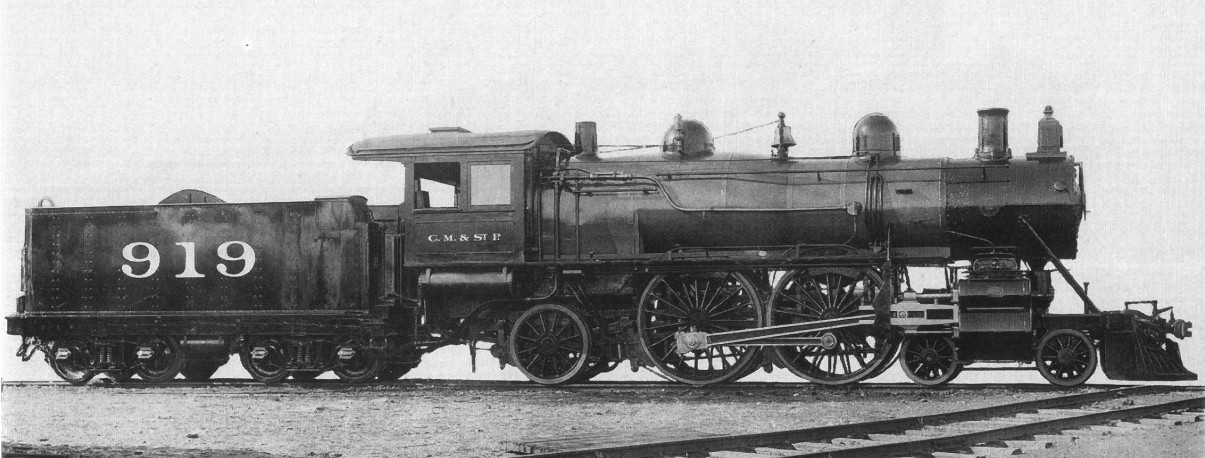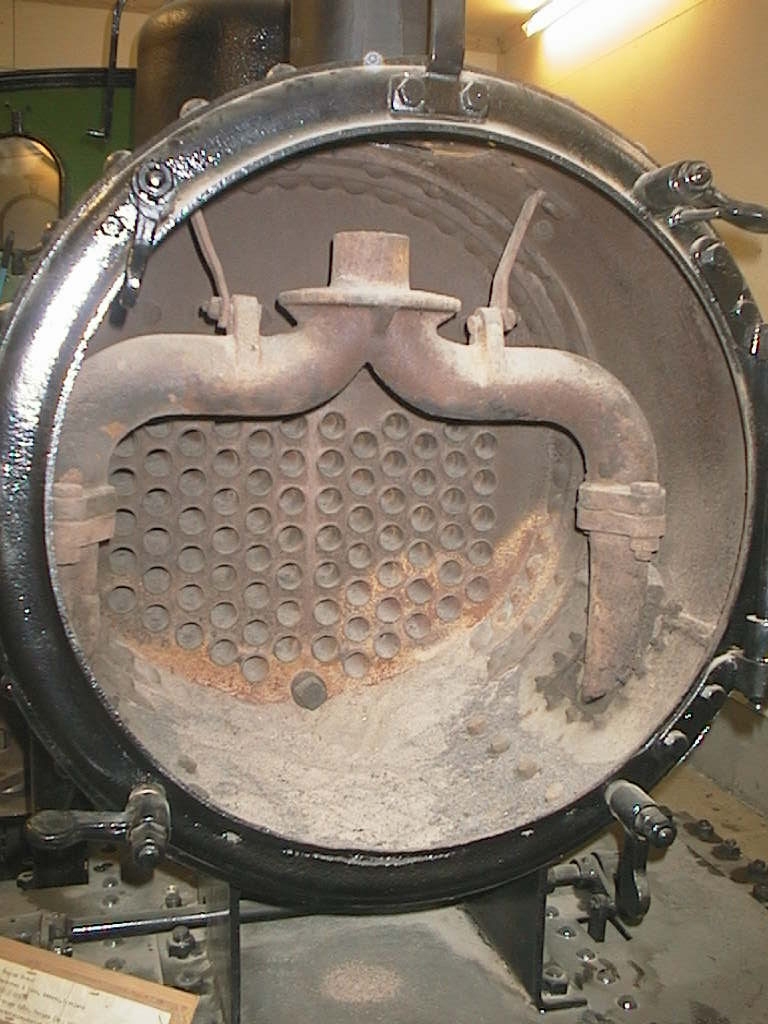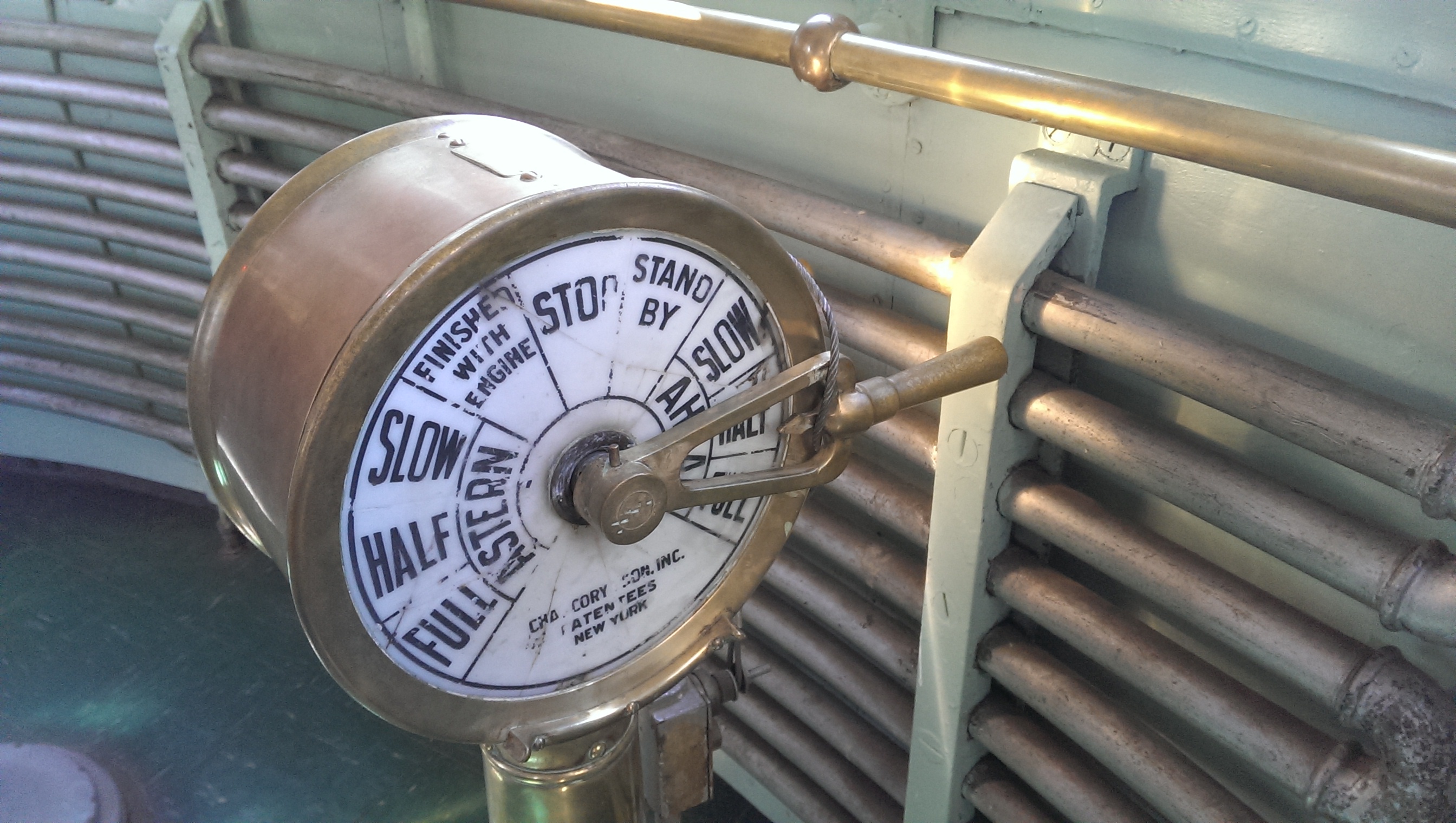|
2-8-8-8-8-2
Under the Whyte notation for the classification of steam locomotives, a 2-8-8-8-8-2 has two leading wheels, four sets of eight driving wheels, and two trailing wheels. Because of its length, such a locomotive must be an multiplex locomotive. It is longer than a normal articulated locomotive; the fourth set of drivers is located under the tender. Other equivalent classifications are: UIC classification: 1-D-D-D-D-1 (also known as German classification and Italian classification) AAR classification: 1-D-D-D-D-1 French classification: 140+040+040+041 Turkish classification: 45+44+44+45 Swiss classification: 4/5+4/4+4/4+4/5 The equivalent UIC classification is to be refined to (1'D)DD(D1'). Usage This type of articulated locomotive was never built, the only proposal for such a locomotive came from the United States. George R. Henderson was granted US Patent 1,100,563 for a quadruplex locomotive, in June 1914. The patent was assigned to the Baldwin Locomotive Company. Baldwin pres ... [...More Info...] [...Related Items...] OR: [Wikipedia] [Google] [Baidu] |
Jointed-boiler Locomotive
A jointed-boiler locomotive was a variant of the Mallet articulated locomotive, in which a flexible coupling was introduced midway along the length of the boiler casing, which allowed the boiler to bend laterally when the locomotive was on curved track. Six such locomotives, all of 2-6-6-2 wheel arrangement, were built for the Atchison, Topeka & Santa Fe Railroad in 1910 and 1911. The first one built, number 1157, was assembled by the AT&SF in their Topeka shops from two 2-6-2’s (numbers 1051 and 1125). All the rest were built new by Baldwin Locomotive Works. Design In a conventional Mallet, the rigid boiler is fixed to the rearmost of the two engine frames, with the front of the boiler supported on a sliding bearing over the pivoting front engine such that when the locomotive traverses a curved track, the front ( smokebox) end of the boiler overhangs toward the outside of the curve. The jointed boiler, with the front half rigidly fixed to the front engine, eliminated this over ... [...More Info...] [...Related Items...] OR: [Wikipedia] [Google] [Baidu] |
Multiplex Locomotive
A multiplex locomotive is a steam locomotive that divides the driving force on its wheels by using multiple pairs of cylinders to drive multiple driving wheel set groups. Such a locomotive will necessarily articulated if it has more than two sets of driving wheels. There were locomotive projects with three, four, five or six sets of drive wheels. However, these locomotives were never built, except for four triplex locomotives in the United States and one quadruplex locomotive in Belgium. The names of the subgroups of multiplex locomotives is derived from the number of drive wheel sets and is composed of the numeral prefix and the word ''locomotive''. However, ''locomotive'' is often omitted if it can be inferred from the context. Duplex locomotives The terms '' duplex locomotive'' and ''Divided drive locomotive'' are used to describe locomotives with two drive wheel sets mounted in a rigid frame. The concept of the duplex locomotive originated in the early development ... [...More Info...] [...Related Items...] OR: [Wikipedia] [Google] [Baidu] |
Jointed-boiler Locomotive
A jointed-boiler locomotive was a variant of the Mallet articulated locomotive, in which a flexible coupling was introduced midway along the length of the boiler casing, which allowed the boiler to bend laterally when the locomotive was on curved track. Six such locomotives, all of 2-6-6-2 wheel arrangement, were built for the Atchison, Topeka & Santa Fe Railroad in 1910 and 1911. The first one built, number 1157, was assembled by the AT&SF in their Topeka shops from two 2-6-2’s (numbers 1051 and 1125). All the rest were built new by Baldwin Locomotive Works. Design In a conventional Mallet, the rigid boiler is fixed to the rearmost of the two engine frames, with the front of the boiler supported on a sliding bearing over the pivoting front engine such that when the locomotive traverses a curved track, the front ( smokebox) end of the boiler overhangs toward the outside of the curve. The jointed boiler, with the front half rigidly fixed to the front engine, eliminated this over ... [...More Info...] [...Related Items...] OR: [Wikipedia] [Google] [Baidu] |
Quadruplex Locomotive
A multiplex locomotive is a steam locomotive that divides the driving force on its wheels by using multiple pairs of cylinders to drive multiple driving wheel set groups. Such a locomotive will necessarily articulated if it has more than two sets of driving wheels. There were locomotive projects with three, four, five or six sets of drive wheels. However, these locomotives were never built, except for four triplex locomotives in the United States and one quadruplex locomotive in Belgium. The names of the subgroups of multiplex locomotives is derived from the number of drive wheel sets and is composed of the numeral prefix and the word ''locomotive''. However, ''locomotive'' is often omitted if it can be inferred from the context. Duplex locomotives The terms ''duplex locomotive'' and ''Divided drive locomotive'' are used to describe locomotives with two drive wheel sets mounted in a rigid frame. The concept of the duplex locomotive originated in the early development of ... [...More Info...] [...Related Items...] OR: [Wikipedia] [Google] [Baidu] |
Whyte Notation
Whyte notation is a classification method for steam locomotives, and some internal combustion locomotives and electric locomotives, by wheel arrangement. It was devised by Frederick Methvan Whyte, and came into use in the early twentieth century following a December 1900 editorial in ''American Engineer and Railroad Journal''. The notation was adopted and remains in use in North America and the United Kingdom to describe the wheel arrangements of steam locomotives (in the latter case also for diesel and electric locomotives), but for modern locomotives, multiple units and trams it has been supplanted by the UIC system in Europe and by the AAR system (essentially a simplification of the UIC system) in North America. Structure of the system Basic form The notation in its basic form counts the number of leading wheels, then the number of driving wheels, and finally the number of trailing wheels, numbers being separated by dashes. For example, a locomotive with two lea ... [...More Info...] [...Related Items...] OR: [Wikipedia] [Google] [Baidu] |
Compound Locomotive
A compound locomotive is a steam locomotive which is powered by a compound engine, a type of steam engine where steam is expanded in two or more stages. The locomotive was only one application of compounding. Two and three stages were used in ships, for example. Compounding became popular for railway locomotives from the early 1880s and by the 1890s were becoming common. Large numbers were constructed, mostly two- and four-cylinder compounds, in France, Germany, Austria, Hungary, and the United States. It declined in popularity due to maintenance issues and because superheating provided similar efficiencies at lower cost. Nonetheless, compound Mallets were built by the Norfolk and Western Railway right up to 1952. Introduction In the usual arrangement for a compound engine the steam is first expanded in one or two high-pressure ''(HP)'' cylinders, then having given up some heat and lost some pressure, it exhausts into a larger-volume low-pressure ''(LP)'' cylinder, (or two, - o ... [...More Info...] [...Related Items...] OR: [Wikipedia] [Google] [Baidu] |
Blast Pipe
The blastpipe is part of the exhaust system of a steam locomotive that discharges exhaust steam from the cylinders into the smokebox beneath the chimney in order to increase the draught through the fire. History The primacy of discovery of the effect of directing the exhaust steam up the chimney as a means of providing draft through the fire is the matter of some controversy, Ahrons (1927) devoting significant attention to this matter. The exhaust from the cylinders on the first steam locomotive – built by Richard Trevithick – was directed up the chimney, and he noted its effect on increasing the draft through the fire at the time. At Wylam, Timothy Hackworth also employed a blastpipe on his earliest locomotives, but it is not clear whether this was an independent discovery or a copy of Trevithick's design. Shortly after Hackworth, George Stephenson also employed the same method, and again it is not clear whether that was an independent discovery or a copy of one of the ... [...More Info...] [...Related Items...] OR: [Wikipedia] [Google] [Baidu] |
Smokebox
A smokebox is one of the major basic parts of a steam locomotive exhaust system. Smoke and hot gases pass from the firebox through tubes where they pass heat to the surrounding water in the boiler. The smoke then enters the smokebox, and is exhausted to the atmosphere through the chimney (or funnel). Early locomotives had no smokebox and relied on a long chimney to provide natural draught for the fire but smokeboxes were soon included in the design for two specific reasons. Firstly and most importantly, the blast of exhaust steam from the cylinders, when directed upwards through an airtight smokebox with an appropriate design of exhaust nozzle, effectively draws hot gases through the boiler tubes and flues and, consequently, fresh combustion air into the firebox. Secondly, the smokebox provides a convenient collection point for ash and cinders ("char") drawn through the boiler tubes, which can be easily cleaned out at the end of a working day. Without a smokebox, all char mus ... [...More Info...] [...Related Items...] OR: [Wikipedia] [Google] [Baidu] |
Voice Pipe
A speaking tube or voicepipe is a device based on two cones connected by an air pipe through which speech can be transmitted over an extended distance. Use of pipes was suggested by Francis Bacon in the ''New Atlantis'' (1672). The usage for telecommunications was experimented and proposed for administrative communications in 1782 by the French monk Dom Gauthey in a memorandum communicated to the Académie des Sciences. Dom Gauthey launched a subscription supported by Benjamin Franklin and other French scientists to finance further experiments, but was not able to raise enough money to go ahead. The British utilitarist philosopher Jeremy Bentham proposed the inclusion of "conversation tubes" in the architecture of his Panopticon (1787, 1791, 1811) and then as a means of military telecommunication (1793) and at the end as a necessary equipment in the architecture of ministries (1825). While its most common use was in intra-ship communications, the principle was also used in af ... [...More Info...] [...Related Items...] OR: [Wikipedia] [Google] [Baidu] |
Engine Order Telegraph
An engine order telegraph or E.O.T., also referred to as a Chadburn, is a communications device used on a ship (or submarine) for the pilot on the bridge to order engineers in the engine room to power the vessel at a certain desired speed. Construction In early vessels, from the 19th century until about 1950, the device usually consisted of a round dial about in diameter with a knob at the center attached to one or more handles, and an indicator pointer on the face of the dial. There would also be a revolutions per minute Revolutions per minute (abbreviated rpm, RPM, rev/min, r/min, or with the notation min−1) is a unit of rotational speed or rotational frequency for rotating machines. Standards ISO 80000-3:2019 defines a unit of rotation as the dimensio ... indicator, worked by a hand crank. Modern EOTs on vessels which still use them use electronic light and sound signals. Operation Traditional E.O.T.s required a pilot wanting to change speed to "ring" the ... [...More Info...] [...Related Items...] OR: [Wikipedia] [Google] [Baidu] |
Firebox (steam Engine)
In a steam engine, the firebox is the area where the fuel is burned, producing heat to boil the water in the boiler. Most are somewhat box-shaped, hence the name. The hot gases generated in the firebox are pulled through a rack of tubes running through the boiler. Steam locomotive fire tube firebox In the standard steam locomotive fire-tube boiler, the firebox is surrounded by water space on five sides. The bottom of the firebox is open to atmospheric pressure, but covered by fire grates (solid fuel) or a firing pan (liquid fuel). If the engine burns solid fuel, like wood or coal, there is a grate covering most of the bottom of the firebox to hold the fire. An ashpan, mounted underneath the firebox and below the grates, catches and collects hot embers, ashes, and other solid combustion waste as it falls through the grates. In a coal-burning locomotive, the grates may be shaken to clean dead ash from the bottom of the fire. They are shaken either manually or (in larger locomotiv ... [...More Info...] [...Related Items...] OR: [Wikipedia] [Google] [Baidu] |
Fireman (steam Engine)
A fireman, stoker or watertender is a person whose occupation it is to tend the fire for the running of a boiler, heating a building, or powering a steam engine. Much of the job is hard physical labor, such as shoveling fuel, typically coal, into the boiler's firebox. On steam locomotives the title ''fireman'' is usually used, while on steamships and stationary steam engines, such as those driving saw mills, the title is usually ''stoker'' (although the British Merchant Navy did use ''fireman''). The German word ''Heizer'' is equivalent and in Dutch the word ''stoker'' is mostly used too. The United States Navy referred to them as ''watertenders''. Nautical Royal Navy The Royal Navy used the rank structure ordinary stoker, stoker, leading stoker, stoker petty officer and chief stoker. The non-substantive (trade) badge for stokers was a ship's propeller. Stoker remains the colloquial term used to refer to a marine engineering rating, despite the decommissioning of the la ... [...More Info...] [...Related Items...] OR: [Wikipedia] [Google] [Baidu] |









